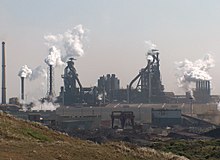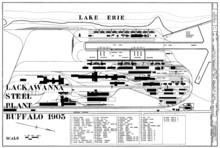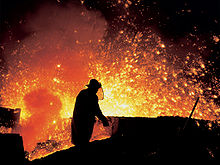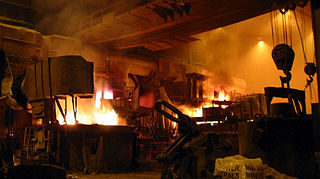
Steelmaking is the process of producing steel from iron ore and/or scrap. Steel has been made for millennia, and was commercialized on a massive scale in the 1850s and 1860s, using the Bessemer and Siemens-Martin processes.

The general term slag may be a by-product or co-product of smelting (pyrometallurgical) ores and recycled metals depending on the type of material being produced. Slag is mainly a mixture of metal oxides and silicon dioxide. Broadly, it can be classified as ferrous, ferroalloy or non-ferrous/base metals. Within these general categories, slags can be further categorized by their precursor and processing conditions. Slag generated from the EAF process can contain toxic metals, which can be hazardous to human and environmental health.

A blast furnace is a type of metallurgical furnace used for smelting to produce industrial metals, generally pig iron, but also others such as lead or copper. Blast refers to the combustion air being supplied above atmospheric pressure.

Nucor Corporation is an American company based in Charlotte, North Carolina, that produces steel and related products. It is the largest steel producer in the United States and the largest recycler of scrap in North America. Nucor is the 16th-largest steel producer in the world. Along with Commercial Metals Company, it is one of two primary suppliers of rebar used to reinforce concrete in buildings, bridges, roads, and infrastructure in the U.S.
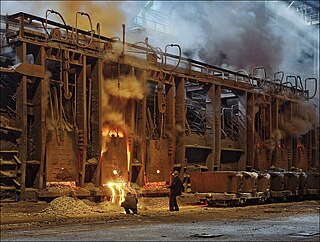
An open-hearth furnace or open hearth furnace is any of several kinds of industrial furnace in which excess carbon and other impurities are burnt out of pig iron to produce steel. Because steel is difficult to manufacture owing to its high melting point, normal fuels and furnaces were insufficient for mass production of steel, and the open-hearth type of furnace was one of several technologies developed in the nineteenth century to overcome this difficulty. Compared with the Bessemer process, which it displaced, its main advantages were that it did not expose the steel to excessive nitrogen, was easier to control, and permitted the melting and refining of large amounts of scrap iron and steel.
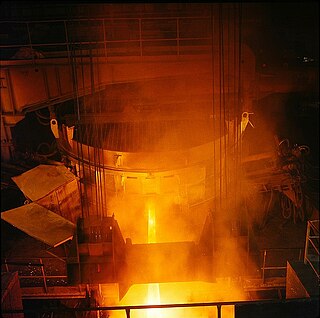
An electric arc furnace (EAF) is a furnace that heats material by means of an electric arc.

An ironworks or iron works is an industrial plant where iron is smelted and where heavy iron and steel products are made. The term is both singular and plural, i.e. the singular of ironworks is ironworks.
ArcelorMittal South Africa is part of the steel company Arcelor-Mittal. The company was originally Iscor Ltd., a South African parastatal steel company. It was founded in 1928 and was first listed on the JSE Securities Exchange in 1989.
Hyundai Steel Co., Ltd, or HSC is a steel making company headquartered in Incheon and Seoul, South Korea, and a member of the Hyundai Motor Group. It manufactures a wide variety of products ranging from H-beams, rail and reinforcing bars, to hot coil, cold-rolled steel, and stainless cold-rolled sheet.
FINEX is the name for an iron making technology developed by former Siemens VAI and POSCO. Molten iron is produced directly using iron ore fines and non-coking coal rather than traditional blast furnace methods through sintering and reduction with coke. Elimination of preliminary processing is claimed to make the plant for FINEX less expensive to build than a blast furnace facility of the same scale, additionally a 10-15% reduction in production costs is expected/claimed through cheaper raw materials, reduction of facility cost, pollutant exhaustion, maintenance staff and production time. The process is claimed to produce less pollutants such as SOx, NOx, and carbon dioxide than traditional methods.

Port Talbot Steelworks is a steel mill in Port Talbot, Wales. Over 4,000 people worked at the plant until the last blast furnace closed in October 2024. Around 2,000 employees remain after this time, processing imported steel slabs to produce rolled steel products. The mill is in the process of building a 320-ton capacity electric arc furnace which would be operational in late 2027.
The Park Gate Iron and Steel Company was a British company that smelted iron ore and turned it into rolled steel and semi-finished casting products. Its works was at Parkgate, South Yorkshire on a triangular site bounded on two sides by the main road between Rotherham and Barnsley (A633) and the North Midland Railway main line between Rotherham Masborough and Cudworth. It also operated ironstone quarries in Northamptonshire and Leicestershire.

The Ravenscraig steelworks, operated by Colvilles and from 1967 by British Steel Corporation, consisted of an integrated iron and steel works and a hot strip steel mill. They were located in Motherwell, North Lanarkshire, Scotland.
PT Krakatau Steel (Persero) Tbk is the largest steel maker in Indonesia, headquartered in Cilegon, Banten. The factory is set on a 280-hectare (700-acre) plot in the western end of Banten and adjacent to the Sunda Strait, and where the Krakatoa volcano and island from which the company takes its name are located.
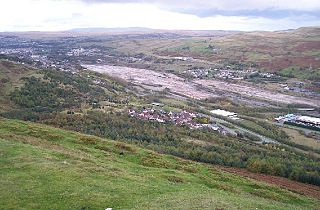
Ebbw Vale Steelworks was an integrated steel mill located in Ebbw Vale, South Wales. Developed from 1790, by the late 1930s it had become the largest steel mill in Europe. It was nationalised after World War II. As the steel industry changed to bulk handling, iron and steel making was ceased in the 1970s, and the site was redeveloped as a specialised tinplate works. It was closed by Corus in 2002, but is being redeveloped in a joint partnership between Blaenau Gwent Council and the Welsh Government.
This steelmaking plant was originally part of the Ford Motor Company, which created an integrated manufacturing complex to produce all major vehicle components at one large facility called The Rouge. In 1989, Ford's steel mill assets were divested and became known as Rouge Industries with the steel operations trading as Rouge Steel Company in Dearborn, Michigan, outside of Detroit.

The Iron and Steel Industry in Scunthorpe was established in the mid 19th century, following the discovery and exploitation of middle Lias ironstone east of Scunthorpe, Lincolnshire, England.
In 2022, the U.S. was the third-largest producer of raw steel worldwide, after China and India, and ranked sixth in pig iron production. By November 2024, the industry produced over 74 million net tons annually.

The US iron and steel industry has paralleled the industry in other countries in technological developments. In the 1800s, the US switched from charcoal to coal in ore smelting, adopted the Bessemer process, and saw the rise of very large integrated steel mills. In the 20th century, the US industry successively adopted the open hearth furnace, then the basic oxygen steelmaking process. Since the American industry peaked in the 1940s and 1950s, the US industry has shifted to small mini-mills and specialty mills, using iron and steel scrap as feedstock, rather than iron ore.

The Lithgow Blast Furnace is a heritage-listed former blast furnace and now park and visitor attraction at Inch Street, Lithgow, City of Lithgow, New South Wales, Australia. It was built from 1906 to 1907 by William Sandford Limited. It is also known as Eskbank Ironworks Blast Furnace site; Industrial Archaeological Site. The property is owned by Lithgow City Council. It was added to the New South Wales State Heritage Register on 2 April 1999.
